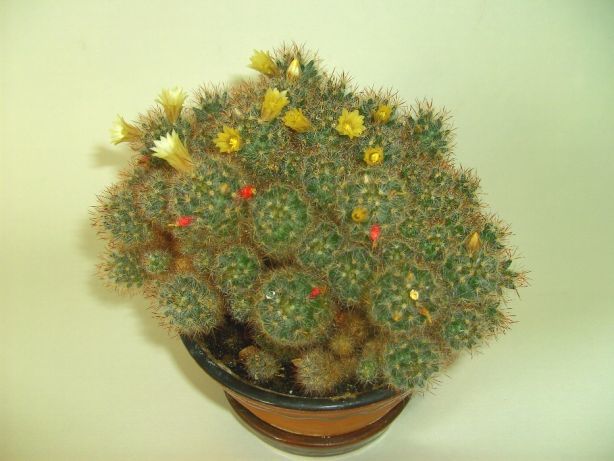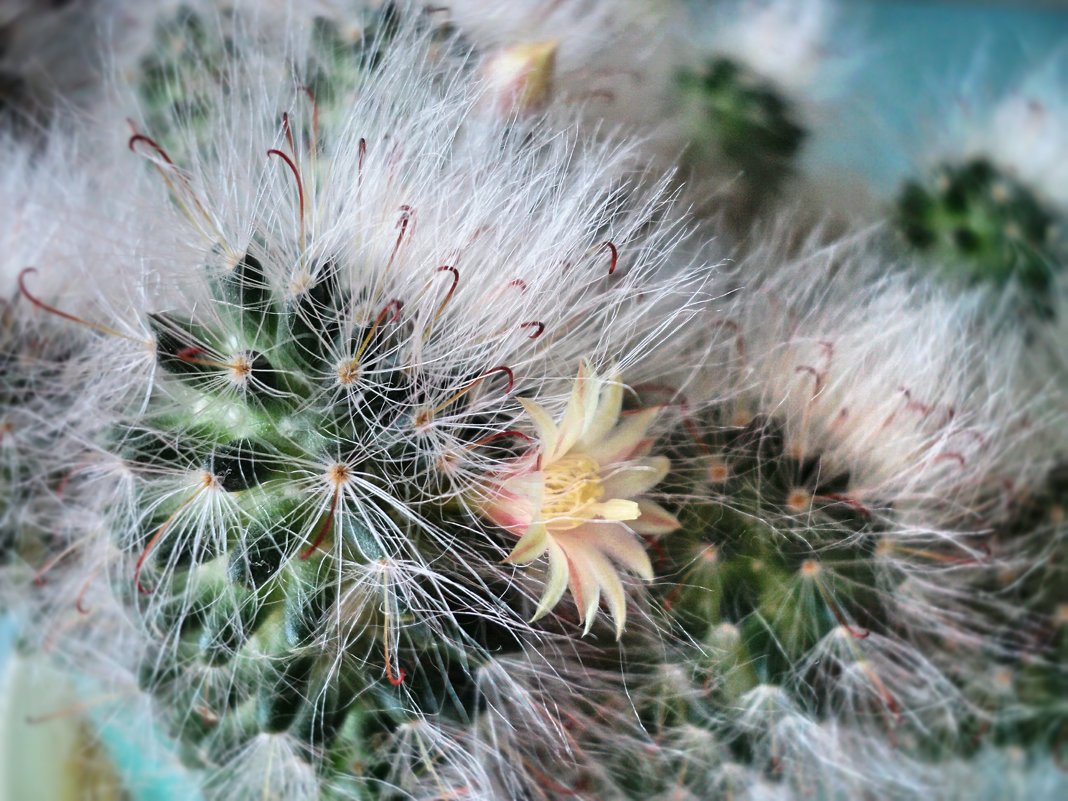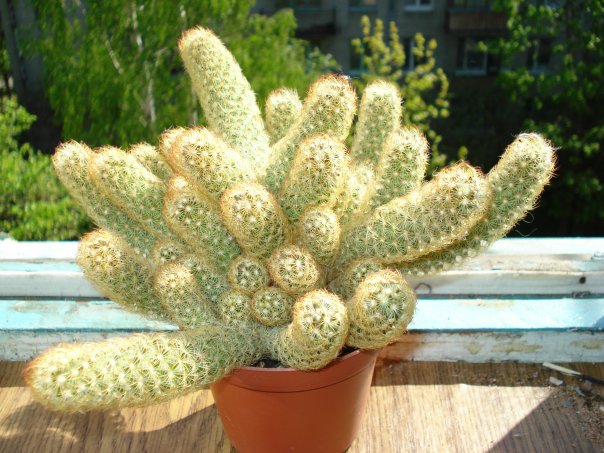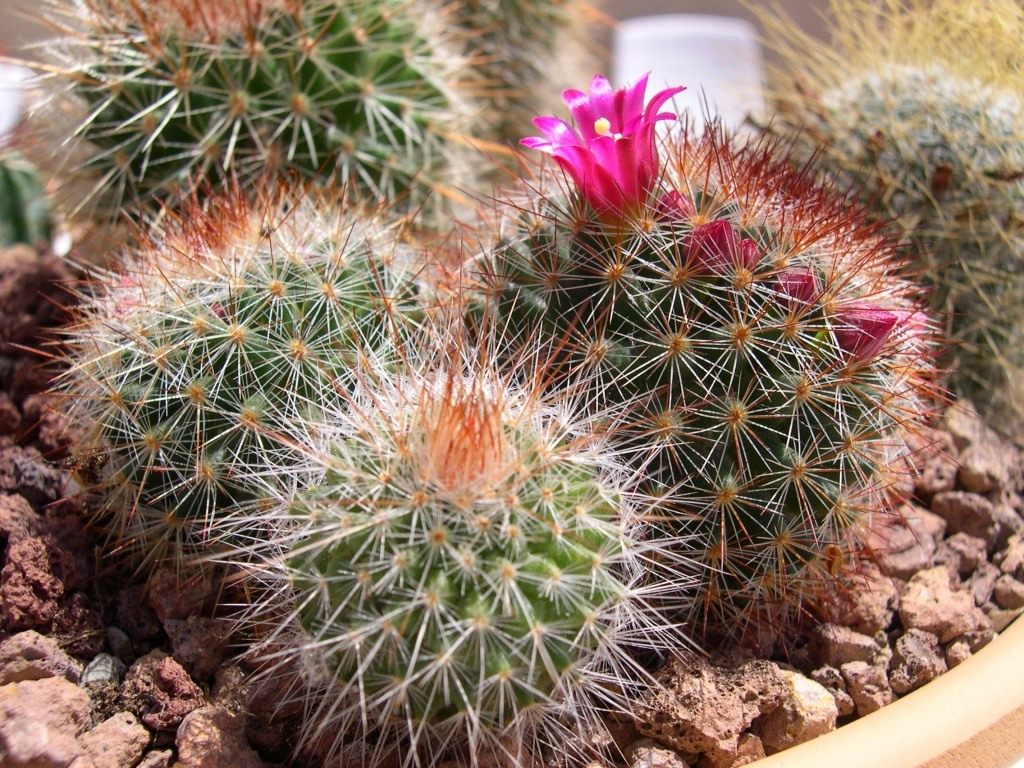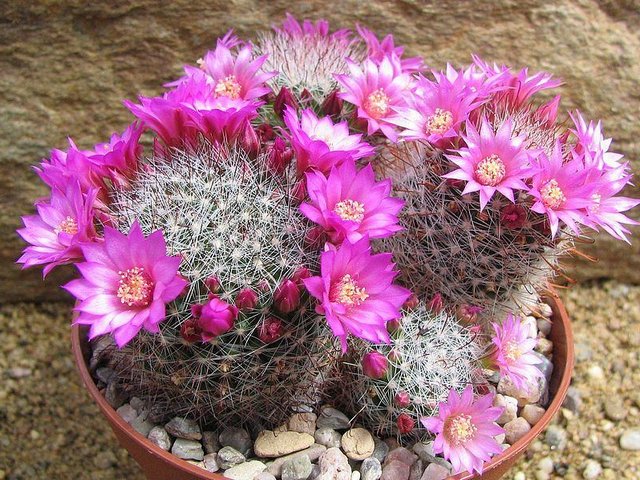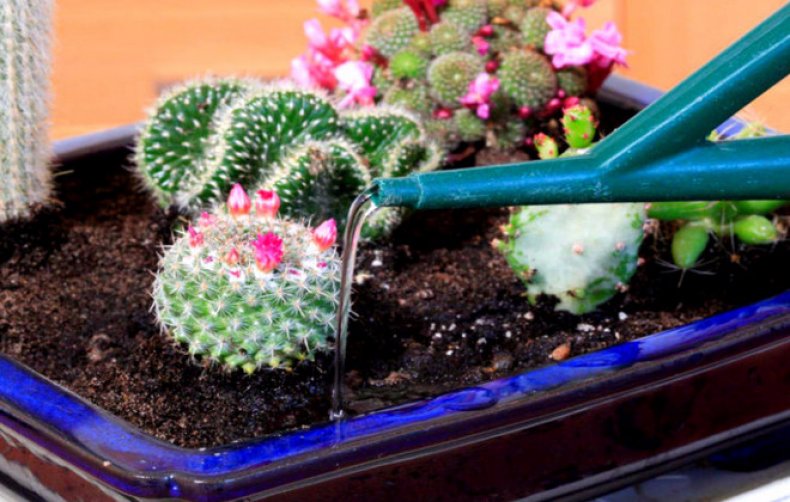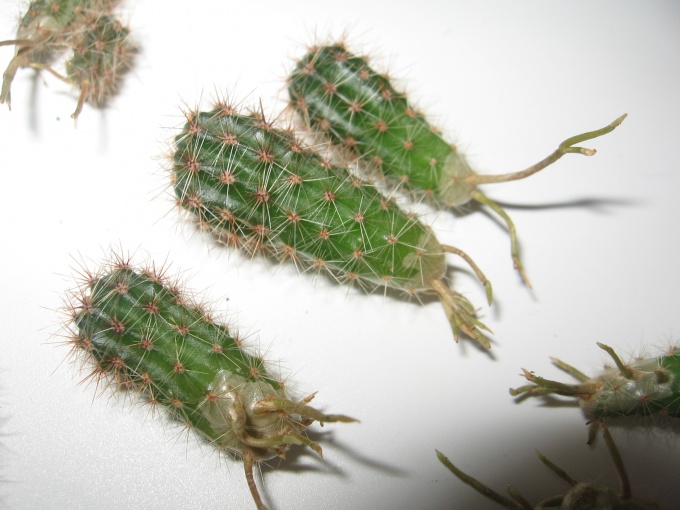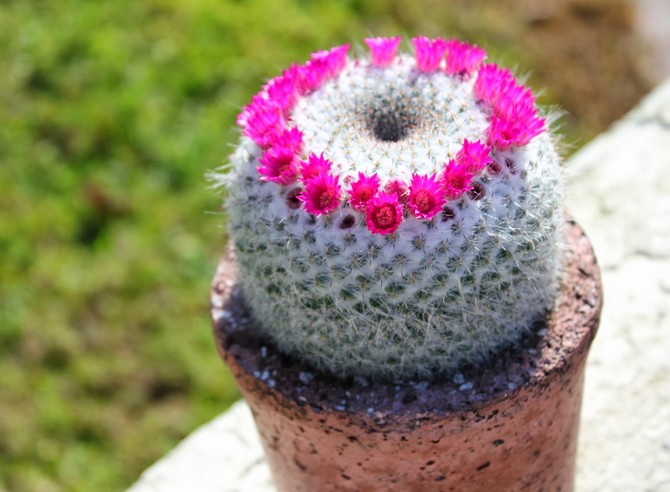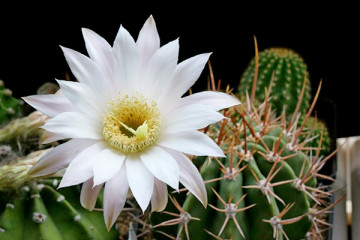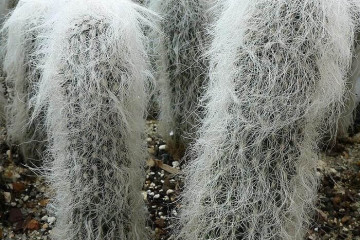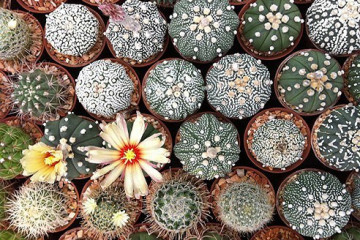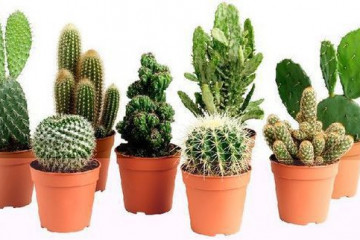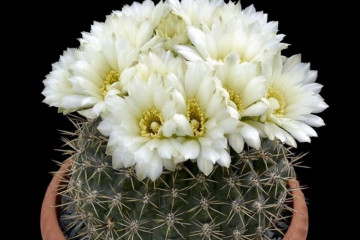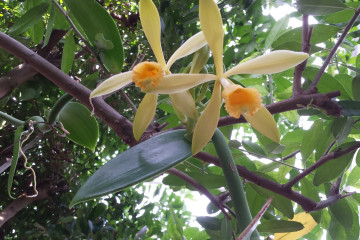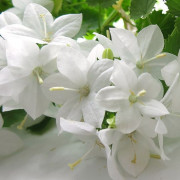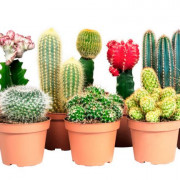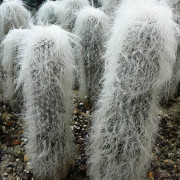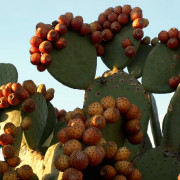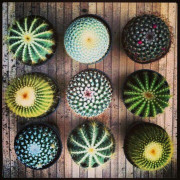Mammillaria cactus: plant care methods and popular species
Content:
The genus Mammillaria has about 200 species of cacti. Among them there are both unpretentious and often found among indoor plant lovers, as well as very rare and demanding care. Readers will be interested in how to properly care for the Mammillaria cactus, what are the varieties of this plant.
Mammillaria species
If the florist decided to breed the Mammillaria cactus, their species are very diverse. Among mammillaria, there are short-cylindrical or spherical varieties. The stems are covered with overgrown leaf bases - papillae, at the top of which there is an areola, i.e. altered axillary kidney. There is also a bunch of hairs, spines. Babies and flowers appear in the sinuses of the papillae.
Most species of mammillaria are decorative, they are grown indoors and in greenhouses.
Mammillaria Prolifera
Another name for this species is the shoot-bearing mammillaria. The word "prolifera" in translation means "bearing offspring." This name is given because of the distinctive ability of the plant to form a large number of shoots - "children". Mammillaria Prolifera grows in a natural zone - the southern states of the United States and Mexico.
The prolifera blooms regularly. Usually this phenomenon resumes from the beginning of spring. Flowers appear within a few weeks. They have a pale yellow, sometimes creamy hue. There are a lot of buds. Sometimes it seems that the plant is simply covered with beautiful and delicate flowers.
The fruits of this cactus are oblong, long, red. They are not edible. They stay on the plant for a long time, decorating it. They rarely appear at home. It takes a lot of warmth to please the eye.
Prolifera cacti are self-pollinating. The stem is spherical, sometimes elongated. Its diameter reaches 4 cm, height - 8 cm. It has a dark green color and branches in the lower part. The lateral processes are babies, sometimes intertwined.
The papillae are round and soft. In the center, there are 5 to 10 thorns. They are yellow and can be up to 8 mm long. The same thorns that overgrow the entire cactus are white, thin and grow up to one centimeter in length. Usually, up to 50 thorns can be counted on the whole plant.
The described species needs a lot of light. It will feel good on the south side, it will not suffer at all from direct sunlight. Since spring, the cactus needs fertilization with a specially developed solution.
Mammillaria Bokasana
The difference between this species is the presence of soft spherical stems and small cylindrical tubercles. At the apex of each tubercle there are one or two red spines, which are surrounded by a fluff of white and very fine hairs. Their length reaches 2 cm, in a bundle they can be up to 50 and even more.
Due to the presence of cannon spines, the whole cactus resembles a small balloon. Its diameter reaches 5 cm and more.
Early enough, a large number of processes are formed on the spherical stem. In early spring, buds appear at the top of the plant, from which graceful flowers up to 2 cm in diameter bloom. They are white or pinkish in color.
Mammillaria Bokasana reproduces very easily, therefore it is common among cactus lovers. Different plant specimens differ in size, length and number of small thorns, their color. Some hybrid varieties delight the eyes of flower growers with especially bright flowers.
There is a form of Bokassian mammillaria, which is practically devoid of hairs and spines. The stem of some Mammillaria mix is soft, light green, covered with small warts. In some varieties, the stem is yellow-green. All these amazing varieties of cactus have given him the opportunity to gain popularity among flower growers.
Mammillaria Elongata
Another name for this cactus is elongated mammillaria. This is a very variable species of cactus in the thickness of the stems and the length of the thorns. The stem is cylindrical, green. In length it reaches up to 10 centimeters. The plant is able to bush well and beautifully. Ideal for decorating small rooms.
The papillae are small, cone-shaped. The sinuses between them are bare. The spines are arranged in a ray-like manner. In one "point" there are from 12 to 22 spines of different shades: from straw to reddish brown. There are no central spines with rare exceptions.
Mammillaria Elongata has small flowers of light yellow or pink color. The same flowers can be seen in the Mammillaria Karvinsky, Carmen.
When caring for this plant, you need to remember that in the summer it should be provided with sufficient watering. In winter, the plant is not watered at all, placing it in a cool room. It should be illuminated intensively, even on hot summer days. Elongat needs to be transplanted once every 2 or 3 years. Before transplanting, the plant is watered so that the clod of earth is well separated from the plant.
Mammillaria plumosa
Another name for the plant is pinnate mammillaria. This is a very luxurious type of cactus. The plant is very fluffy, covered with a large number of thorns and fuzzies. The stem is spherical, 5 to 7 cm in diameter.
As it grows, the cactus turns into one large pillow covered in white fluff. Its diameter can reach 20 cm.
Mammillaria plumosa bloom extremely rarely. If you are lucky enough to see a flower, it will be small - about one and a half centimeters in diameter and white. Flowers timidly rise above a cloud of fluffy thorns, then curl inward.
You need to keep such beauty on a sunny windowsill. For the plant, choose the most loose soil. Water very sparingly, avoiding droplets of water falling on delicate thorny fluffs.
Mammillaria Wilda
This is one of the most unpretentious types of cacti. The stem grows up to 15 cm in height and up to 6 cm in diameter. It branches from the base. The papillae are soft, pink at the base. The sinus has several hair-like bristles. The spines are located radially: at each "point" there are about a dozen small needles. They are transparent, light yellow in color.
The flower of Vilda's mammillaria is about a centimeter in diameter, cream or white. After flowering, a small berry is formed. The same can be observed in the Mammillaria Arizona and Baum.
Mammillaria prickly
This cactus has a light green or bluish green stem. In height it reaches 25 cm, in diameter - up to 10. The sinus between the papillae has white spines and bristles.
In total, about 15 central spines grow. They are elastic, have different lengths and colors: there are yellow, white and even red variants. There are about 20 radial spines. They look like bristles and reach 1 cm in length.
The flowers are pink or purple, up to 2 cm in diameter.
Mammillaria is excellent
This plant has a spherical or slightly elongated stem. In diameter, it can reach 6 cm. The sinuses have small spines-hairs. Numerous radial spines (from 14 to 30 pcs.), White. Their length is about 3 mm. Central spines grow in length from 2 to 6 mm.
The flowers of the Mammillaria Gracilis are red or pink. Their diameter is about one and a half centimeters.
Mammillaria Zeilman
It is a rather small cactus with a light green stem. Its shape is cylindrical. A large number of shoots are formed on the sides. The cactus is covered with many fine needles and light long hairs.
The peculiarity of Zeilman's mammillaria is that it gives flowers of pink and purple tones, located around the entire circumference of the stem. Thus, the plant resembles one large wreath.
The plant can grow up to 10 centimeters in height and 6 centimeters in diameter. The difference between this cactus and others is the duration of flowering. Under favorable conditions, it reaches 6 months and even more.
The cactus tolerates low temperatures well, due to waterlogging of the soil, the roots begin to rot, and the plant dies.
Home care rules
Home care and flowering of mammillaria are closely interrelated. Subject to simple recommendations, the plant will delight the eyes with its flowering for a long time.
Transfer
If mammillaria grows in the house, caring for it provides for periodic transplants.
When transplanting a plant, perform the following actions:
- They take it out of the pot, shake off the roots and examine it for damage, disease and pests.
- If the roots are clean, then the plant is placed in a new pot.
- In the presence of diseases and pests, appropriate treatment is carried out
Soil and watering
The soil mixture for this plant is prepared by mixing leaf and turf soil, peat and a little crushed brick chips. You can buy ready-made soil from a flower shop, specially prepared for cacti.
It is necessary to water the plant once a week. In winter, it is not watered at all, this is required by the life cycle. In the warm season, the plant can be irrigated with a spray bottle.
Lighting and temperature
Mammillaria loves bright sunlight. From its lack, the cactus begins to stretch up and towards the light source. This significantly impairs the decorative properties of the plant. The pot can be safely placed on the sunny side even on the hottest summer days.
The optimum air temperature for a cactus is from 22 to 25 degrees. In winter, you need to ensure that the temperature in the room is about 12-15 degrees. Some species can be kept at even colder temperatures without fear of freezing.
Reproduction
Mammillaria cacti are propagated by children and with the help of seeds.
Children
You need to do the following:
- Carefully separate the scion from the mature plant. It is best to carry out this operation with a sharp and disinfected knife.
- Dry the baby under normal conditions for 2 days.
- Prepare a small container, drop the baby off, put in a warm room, where there is no direct sunlight.
- Be sure to water the baby after the transplant.
Seeds
In this case, you need to perform the following sequence of actions:
- Sow seeds into prepared soil, sprinkle them and place in a warm place without direct sunlight.
- After emergence, the pot is transferred to the sun.
Diseases, pests of mammillaria
The most dangerous parasite is the red tick. It feeds on plant juices, polluting it with waste products.As soon as the pest is found, the plant is treated with an insecticidal composition. After a week, the procedure is repeated.
As a result of overflow, root rot is possible. The earliest sign of decay is the blackening and softening of the stem. Over time, spotting appears on it. If the plant is not transplanted, then it will soon die from a change in the structure of the root.
To restore the affected roots, you need:
- remove damaged fragments and immerse the healthy part of the root in a hot water bath for about 10 minutes;
- dry the treated roots, process the places where the cuts were made with chopped charcoal, plant the cactus in new soil.
Blooming cactus
The flowers of these cacti emerge from the buds. Their corollas are in the form of tubes, small circles or bells. Flower sizes are highly species dependent and can range from subtle to almost hooked, with large petals up to 3 cm in diameter.
The shade of the flower petals varies from white, pink and almost to dark red (for example, in Luthi).
The plant begins to bloom in spring or early June. The duration of flowering varies greatly depending on the species: from several weeks to several months and even up to six months.
The Mammillaria cactus is distinguished by its unpretentious care, a wide variety of flower colors. Subject to the rules of care, the plant will delight the eyes for a long time with long flowering.
